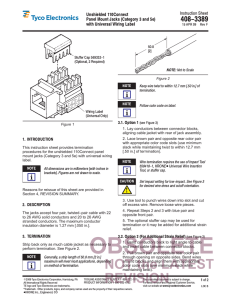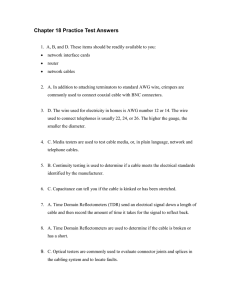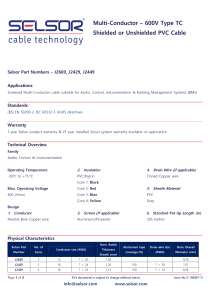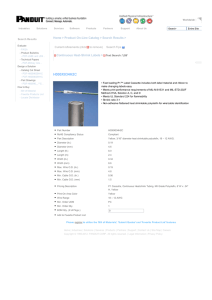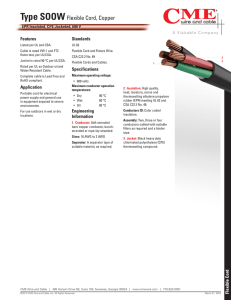county of san joaquin existing sheriff`s office ups replacement project
advertisement
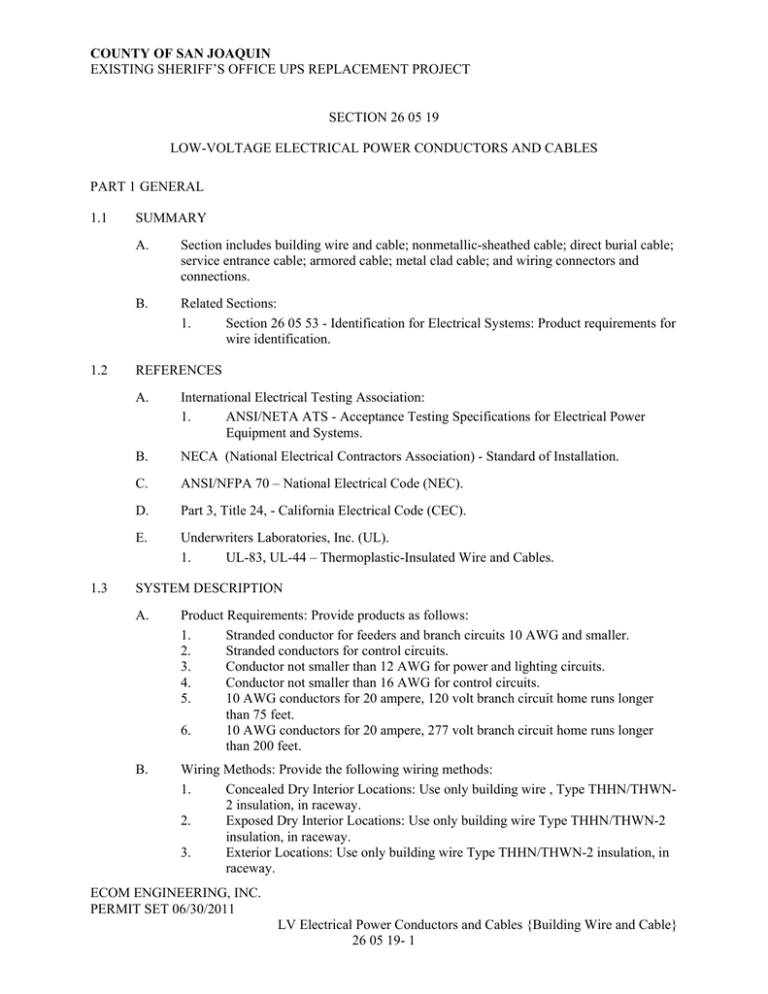
COUNTY OF SAN JOAQUIN
EXISTING SHERIFF’S OFFICE UPS REPLACEMENT PROJECT
SECTION 26 05 19
LOW-VOLTAGE ELECTRICAL POWER CONDUCTORS AND CABLES
PART 1 GENERAL
1.1
1.2
1.3
SUMMARY
A.
Section includes building wire and cable; nonmetallic-sheathed cable; direct burial cable;
service entrance cable; armored cable; metal clad cable; and wiring connectors and
connections.
B.
Related Sections:
1.
Section 26 05 53 - Identification for Electrical Systems: Product requirements for
wire identification.
REFERENCES
A.
International Electrical Testing Association:
1.
ANSI/NETA ATS - Acceptance Testing Specifications for Electrical Power
Equipment and Systems.
B.
NECA (National Electrical Contractors Association) - Standard of Installation.
C.
ANSI/NFPA 70 – National Electrical Code (NEC).
D.
Part 3, Title 24, - California Electrical Code (CEC).
E.
Underwriters Laboratories, Inc. (UL).
1.
UL-83, UL-44 – Thermoplastic-Insulated Wire and Cables.
SYSTEM DESCRIPTION
A.
Product Requirements: Provide products as follows:
1.
Stranded conductor for feeders and branch circuits 10 AWG and smaller.
2.
Stranded conductors for control circuits.
3.
Conductor not smaller than 12 AWG for power and lighting circuits.
4.
Conductor not smaller than 16 AWG for control circuits.
5.
10 AWG conductors for 20 ampere, 120 volt branch circuit home runs longer
than 75 feet.
6.
10 AWG conductors for 20 ampere, 277 volt branch circuit home runs longer
than 200 feet.
B.
Wiring Methods: Provide the following wiring methods:
1.
Concealed Dry Interior Locations: Use only building wire , Type THHN/THWN2 insulation, in raceway.
2.
Exposed Dry Interior Locations: Use only building wire Type THHN/THWN-2
insulation, in raceway.
3.
Exterior Locations: Use only building wire Type THHN/THWN-2 insulation, in
raceway.
ECOM ENGINEERING, INC.
PERMIT SET 06/30/2011
LV Electrical Power Conductors and Cables {Building Wire and Cable}
26 05 19- 1
COUNTY OF SAN JOAQUIN
EXISTING SHERIFF’S OFFICE UPS REPLACEMENT PROJECT
4.
1.4
1.5
DESIGN REQUIREMENTS
A.
Conductor sizes are based on copper unless indicated as aluminum or "AL".
B.
Aluminum conductors shall not be used.
SUBMITTALS
A.
1.6
Manufacturer: Company specializing in manufacturing products specified in this section
with minimum three years experience.
FIELD MEASUREMENTS
A.
1.9
Project Record Documents: Record actual locations of components and circuits.
QUALIFICATIONS
A.
1.8
Product Data: Submit for building wire.
CLOSEOUT SUBMITTALS
A.
1.7
Underground Locations: Use only building wire Type THHN/THWN-2
insulation, in raceway.
Verify field measurements are as indicated on Drawings.
COORDINATION
A.
Where wire and cable destination is indicated and routing is not shown, determine routing
and lengths required.
B.
Determine required separation between wire, cable and other work. Determine cable
routing to avoid interference with other work.
C.
Wire and cable routing indicated is approximate unless dimensioned.
PART 2 PRODUCTS
2.1
BUILDING WIRE
A.
Manufacturers:
1.
Diamond Wire & Cable Co.
2.
Essex Group Inc.
3.
General Cable Co.
4.
Approved equal.
B.
Product Description: Single conductor insulated wire.
C.
Conductor: Copper.
ECOM ENGINEERING, INC.
PERMIT SET 06/30/2011
LV Electrical Power Conductors and Cables {Building Wire and Cable}
26 05 19- 2
COUNTY OF SAN JOAQUIN
EXISTING SHERIFF’S OFFICE UPS REPLACEMENT PROJECT
2.2
Plastic Tape:
A.
2.3
Insulating Resin:
A.
2.4
Use two part liquid epoxy resin with resin and catalyst in premeasured, sealed mixing
pouch. Scotchcast 4 or equivalent.
Reducing Adapters:
A.
2.5
Black 7 mil thick general purpose electrical tape, Scotch 33 plus or equal.
Burndy, Thomas and Betts or approved equal.
WIRING CONNECTORS
A.
Bolted pressure connectors: Cast bronze compression bolts designed for parallel taps,
tees, crosses or end-to-end connections.
B.
Insulated spring wire connectors: Multi-part construction incorporating a steel spring
enclosed with a color coded outer thermoplastic shell.
C.
Compression type termination lugs: Tin plated copper high-compression type lugs for
installation with hand or hydraulically operated crimping tools and dies. Provide 2-hole
lugs for size #4/0 AWG and larger wire where terminated to bus bars.
PART 3 EXECUTION
3.1
3.2
EXAMINATION
A.
Verify interior of building has been protected from weather.
B.
Verify mechanical work likely to damage wire and cable has been completed.
C.
Verify raceway installation is complete and supported.
PREPARATION
A.
3.3
Completely and thoroughly swab raceway before installing wire.
EXISTING WORK
A.
Remove exposed abandoned wire and cable, including abandoned wire and cable above
accessible ceiling finishes. Patch surfaces where removed cables pass through building
finishes.
B.
Disconnect abandoned circuits and remove circuit wire and cable. Remove abandoned
boxes when wire and cable servicing boxes is abandoned and removed. Install blank
cover for abandoned boxes not removed.
C.
Provide access to existing wiring connections remaining active and requiring access.
Modify installation or install access panel.
ECOM ENGINEERING, INC.
PERMIT SET 06/30/2011
LV Electrical Power Conductors and Cables {Building Wire and Cable}
26 05 19- 3
COUNTY OF SAN JOAQUIN
EXISTING SHERIFF’S OFFICE UPS REPLACEMENT PROJECT
3.4
D.
Extend existing circuits using materials and methods compatible with existing electrical
installations, or as specified.
E.
Clean and repair existing wire and cable remaining or wire and cable to be reinstalled.
INSTALLATION
A.
Route wire and cable to meet Project conditions.
B.
Neatly train and lace wiring inside boxes, equipment, and panelboards.
C.
Identify and color code wire and cable under provisions of Section 26 05 53. Identify
each conductor with its circuit number or other designation indicated.
D.
Special Techniques--Building Wire in Raceway:
1.
Pull conductors into raceway at same time.
2.
Install building wire 4 AWG and larger with pulling equipment.
E.
Special Techniques - Cable:
1.
Protect exposed cable from damage.
2.
Support cables above accessible ceiling, using spring metal clips or plastic cable
ties to support cables from structure. Do not rest cable on ceiling panels.
3.
Use suitable cable fittings and connectors.
4.
Armored Cable or Metal Clad Cable is not permitted for homerun use. Extend
cable from junction/wireway box having branch circuits for the immediate area.
Use conduit or electrical metallic tubing for routing branch circuit conductors
from junction/wireway box to panelboard.
5.
AC or MC cable is not permitted for Emergency System wiring.
F.
Special Techniques - Wiring Connections:
1.
Clean conductor surfaces before installing lugs and connectors.
2.
Make splices, taps, and terminations to carry full ampacity of conductors with no
perceptible temperature rise.
3.
Tape uninsulated conductors and connectors with electrical tape to 150 percent of
insulation rating of conductor.
4.
Install solderless tool applied pressure or split bolt connectors and lugs for copper
conductor splices and taps, 8 AWG and larger.
5.
Install insulated spring wire connectors with plastic caps for copper conductor
splices and taps, 10 AWG and smaller.
6.
Encapsulate below grade splices at outlet, pull and junction boxes with specified
insulating resin kits. Make all splices watertight.
7.
Install waterproof wire connectors with plastic caps for copper conductor splices
and taps, 10 AWG and smaller in outdoor or wet locations.
8.
Where oversized cables are used to accommodate voltage drop, whether a single
or parallel feeder, provide appropriate reducing adapter and conductors for
termination.
9.
Terminate aluminum conductors with tin-plated, aluminum-bodied compression
connectors only. Fill with anti-oxidant compound before installing conductor.
10.
Install suitable reducing connectors or mechanical connector adaptors for
connecting aluminum conductors to copper conductors.
ECOM ENGINEERING, INC.
PERMIT SET 06/30/2011
LV Electrical Power Conductors and Cables {Building Wire and Cable}
26 05 19- 4
COUNTY OF SAN JOAQUIN
EXISTING SHERIFF’S OFFICE UPS REPLACEMENT PROJECT
3.5
3.6
WIRE COLOR
A.
General
1.
For wire sizes 10 AWG and smaller, install wire colors in accordance with the
following:
a.
Black and red for single phase circuits at 120/240 volts.
b.
Black, red, and blue for circuits at 120/208 volts single or three phase.
c.
Orange, brown, and yellow for circuits at 277/480 volts single or three
phase.
2.
For wire sizes 8 AWG and larger, identify wire with colored tape at terminals,
splices and boxes. Colors are as follows:
a.
Black and red for single phase circuits at 120/240 volts.
b.
Black, red, and blue for circuits at 120/208 volts single or three phase.
c.
Orange, brown, and yellow for circuits at 277/480 volts single or three
phase.
B.
Neutral Conductors: White. When two or more neutrals are located in one conduit,
individually identify each with proper circuit number.
C.
Branch Circuit Conductors: Install three or four wire home runs with each phase uniquely
color coded.
D.
Feeder Circuit Conductors: Uniquely color code each phase.
E.
Ground Conductors:
1.
For 6 AWG and smaller: Green.
2.
For 4 AWG and larger:Identify with green tape at both ends and visible points
including junction boxes.
FIELD QUALITY CONTROL
A.
Provide visual and mechanical inspection in accordance with NETA ATS, 7.3.2.1.
B.
Perform electrical tests in accordance with NETA ATS, 7.3.2.2
C.
Subject feeder cables sized #2 AWG and larger, rated 600 volts AC to insulation
resistance test.
D.
Do not megger any cables after connecting to any equipment, unless specifically directed
to do so by Architect.
E.
Provide written test results and a final report of electrical tests per NETA ATS 5.4 to
Architect.
END OF SECTION
ECOM ENGINEERING, INC.
PERMIT SET 06/30/2011
LV Electrical Power Conductors and Cables {Building Wire and Cable}
26 05 19- 5
